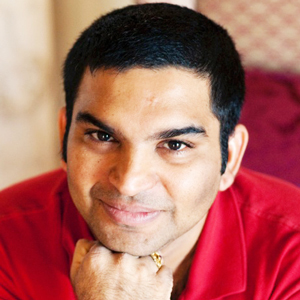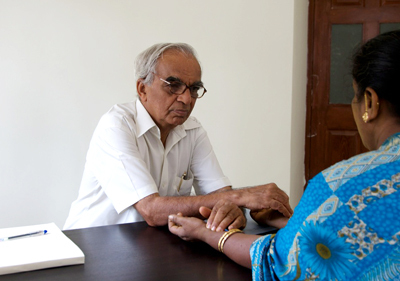I recently interviewed Dr. Kausthub Desikachar by email. He began studying yoga when he was 9 years old under the guidance of his teacher and father TKV Desikachar and started teaching at the age of 13. After completing his dual masters degree at the University of Madras, he committed himself to becoming a full-time student and teacher of yoga. He has also authored and coauthored numerous books on yoga, such as The Heart of Asana: A Comprehensive Manual on Classical Yoga Postures and a biography on his grandfather, T. Krishnamacharya: The Yoga of the Yogi.
"In the tradition of T Krishnamacharya, Yoga Therapy can be defined as a self-empowering process, where the care-seeker, with the help of the yoga therapist, implements a personalized and evolving yoga practice, that not only addresses the illness in a multidimensional manner, but also aims to alleviate his/her suffering in a progressive, non-invasive and complementary manner. Depending on the nature of the illness, Yoga Therapy can not only be preventative or curative, but also serves as means to manage the illness, or facilitate healing in the person at all levels." -- Kausthub Desikachar, "Surgery without Surgical Instruments: The Art of Yoga Therapy"
T. Krishnamacharya, your grandfather, has been credited with reviving yoga and yoga therapy for the modern world. He was the teacher of BKS Iyengar, Patthabi Jois, Indra Devi and TKV Desikachar, among others. How did he see the significance of yoga therapy?
Krishnamacharya saw yoga therapy as a very practical tool for complementary health care in modern society -- as it is not only a self-empowering system but also has other advantages, primary among them being that it is noninvasive. He also viewed yoga therapy as a way for every practitioner to become educated about their own health condition, how it impacts their lifestyle, and how they can manage it independently. He often would define yoga therapy as "surgery without surgical instruments" (yoga cikitsa = aśastra śastra cikitsa).
Are there any prerequisites for a person to benefit from a yoga therapy approach?
Krishnamacharya said that the only prerequisite to engage in yoga therapy is to be able to breathe consciously. Irrespective of age or state of illness, anyone who is able to take responsibility for their health can engage in the process of yoga therapy.
Yoga therapy seems to be growing in people's awareness. What is it providing that is new or additional to people's usual view of yoga?
People generally view yoga as a physical workout. Yoga therapy is bringing awareness to another vast dimension of yoga's tools and how they can be effectively utilized to help all kinds of people improve their quality of life. The perception that yoga is only for flexible, fit people is challenged when more and more people with severe disabilities of the body and mind are able to benefit from yoga therapy. Yoga therapy also contributes to changing how health itself is understood; yoga therapy demonstrates us that the human body is, in reality, a holistic and dynamic entity that is constantly evolving.
Could you say more about mental health conditions? How does yoga therapy see the division made in the West between the body and the mind?
From the point of view of yoga, the body and psyche are very intricately and subtly connected. Yoga does not, in fact, separate the two as independent entities but rather sees that there is a complicated and very intimate connection between body, breath and psyche. From this understanding, it prescribes tools that may appear to be addressing the physical layer of our system but also influence our breath and psyche. Similarly, when yoga therapy seemingly addresses the mind or emotional domains, it will also have an influence on body and breath. Yoga does not address the different components of our body as isolated individual parts, but rather looks at the human system as a holistic interconnected entity. Hence, even certain kinds of mental health conditions can be aided through yoga therapy -- as long as the person is able to empower themselves in the practice and has a competent yoga therapist to guide them in the journey.
You've mentioned the holistic perception yoga therapy has of the human system. Could you go into more detail about how this is reflected in the practice of yoga therapy?
Yoga therapy has much in common with its sister philosophy Āyurveda [Vedic traditional system of medicine, diet and lifestyle]. Yoga and Āyurveda together share a common understanding of the human system and how it functions. Some aspects of this understanding can be similar to how modern medicine views our body. However there are many areas of differences as well where yoga and Āyurveda have their own way of understanding our body holistically and how disease manifests in it. These include subtle layers of our system such as our energetic structure, energy centers in the body (cakra-s), energy pathways such as nāḍi-s, constitutional qualities (guṇa-s and doṣa-s), etc. Hence the understanding and application of yoga's tools are based on this ancient way of looking at the human body and not based on modern medicine. Modern day yoga therapists who attempt to integrate yogic tools through the eyes of modern medicine often fall short. This is why a serious study of how yoga and Āyurveda view the human system through subtle anatomies becomes critical for every yoga therapy practitioner.
T.K.V. Desikachar reading the pulse of a yoga student.
What does yoga therapy have to give the world that is unique?
Yoga therapy teaches us to link back to Self and look for solutions of healing within using our own resources such as body, breath and mind. It teaches us to respect the body as a very subtle, holistic entity. And it teaches us that we are all unique and hence one approach will not work for all.
You have talked about people finding their true potential through an appropriate yoga practice. Can you explain that?
Yoga views each of us as a unique individual being having unique potentials. It strongly advocates that no two of us are the same, but rather we are each different in form. The good thing about being a human is that we have more than one potential possible. So the key is to embrace these potentials and nourish them in the best possible manner. This is also one of the reasons why Yoga practice needs to be individualized. Because no two persons on this planet are the same, the approach needed by each also has to be different. In this manner Yoga actually celebrates the individuality of human potential.
What is the relationship between spirituality and healing?
From the point of view of Yoga, spirituality is defined as the process of identifying the inner light within us and letting that guide our life and our life decisions. Bad health can be an impediment to this process, as it forces us to remain focused on the suffering, rather than on the light within. Thus Yoga suggests that healing is a first step towards spirituality. We need to first heal ourselves from our diseases, be it physical or psychological, so that our energies are not diverted and fragmented. Yoga also advocates that when we let the inner light guide our life, the chances that we err are lessened and hence our suffering also reduces.


